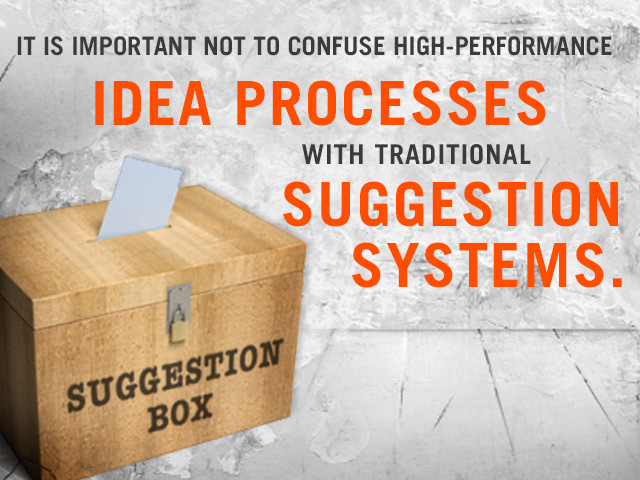Not long ago, the owner of a medium sized software development firm asked me a very good question. “How does a high performance idea system work in a project environment where every project is different?” We discussed that in a project-based company like his there were lots of processes that could be improved, but his question made a good point. A project environment does have unique challenges for a high performance idea system, and there are several different tactics that can be used to integrate ideas more fully into the natural flow of projects.
Historically, high performance idea systems developed in process-based environments – think Toyota for example – where the goal is to repeatedly and consistently duplicate the same outcome. Employee ideas focus on streamlining and continuously improving the procedures, technologies, standard work, and other elements that make up relatively stable processes. But a project dominated environment is often more dynamic, with each project potentially having unique elements. At the same time, projects have a natural “pulse” – a defined beginning, regular reviews, and clear ending – that can be used advantageously in idea management.
One of our favorite ways to start a project is to conduct a “pre-mortem” by asking the members of the project team the following question: “If you could get in a time machine and travel forward to a date six months after the scheduled completion of the project and found that it had been unsuccessful, what would you see as the primary causes for its failure?” The resulting discussion is often spirited and comes up with responses such as “Poor communication leads to confusion and misunderstanding,” “Passive resistance from key constituents undermined the project’s effectiveness,” “Supporting functions and suppliers missed deadlines and we ended up going over budget.” Often relatively minor ideas for tweaks in the project management process or that can be easily incorporated into the project’s plan can mitigate most of the sources of failure that were identified. A good pre-mortem also starts the team off by confirming that they are responsible for the success of the project and their ideas are important to achieve that success.
Well managed projects have regular meetings to review progress, identify delays or concerns, discuss ways to deal with them, decide what actions are to be taken by whom, and generally keep everyone up to date on the progress of the project. In a number of ways these meetings are similar to idea meetings. Problems are identified, ideas for solving them are discussed, and action steps are assigned. But there is a subtle but important difference in the goals of two types of meetings. Project meetings focus on addressing issues related to a specific project; whereas idea meetings focus on capturing ideas to help the organization continually improve. At a project meeting it would be perfectly appropriate to suggest a one-time “patch” on a problem to keep everything on time or overcome a barrier; however such an action would be considered inappropriate at idea meetings with its goal of identifying and eliminating the root cause of the problem.
Regular project meetings can double as idea meetings, but in order to do so team members need to be willing to analyze issues with an eye toward identifying their causes and developing ideas that assure that the problems do not reappear with future projects. If the root cause cannot be identified and eliminated immediately, the issue should be captured and documented for further action later, often during the project close out.
Before the celebration of the completion of a project, it must be properly closed out. It is surprising how often this logical and vital step is given short shrift as team members are anxious to move on to new assignments. From an idea perspective the critical elements of a close are a thorough post-mortem that captures improvement ideas, documentation of the lessons learn throughout the project, revisiting the problems encountered along to way to see if there are any opportunities for ideas on improving the project management process, and make certain that all ideas for process changes that were decided upon are made and fully documented.
One of the more interesting challenges when putting a high-powered idea system in a project environment is that project team members are often people who already consider coming up with ideas as a major part of their jobs – engineers, designers, marketers, etc. Initially they often don’t see the need for a formal idea system. The key to implementing a system in such situations is to make as few changes as possible. Simply change the existing project management process to incorporate idea management into every step. These subtle changes will usually be seen as nothing more than logical improvements that make their jobs easier in the long run.


